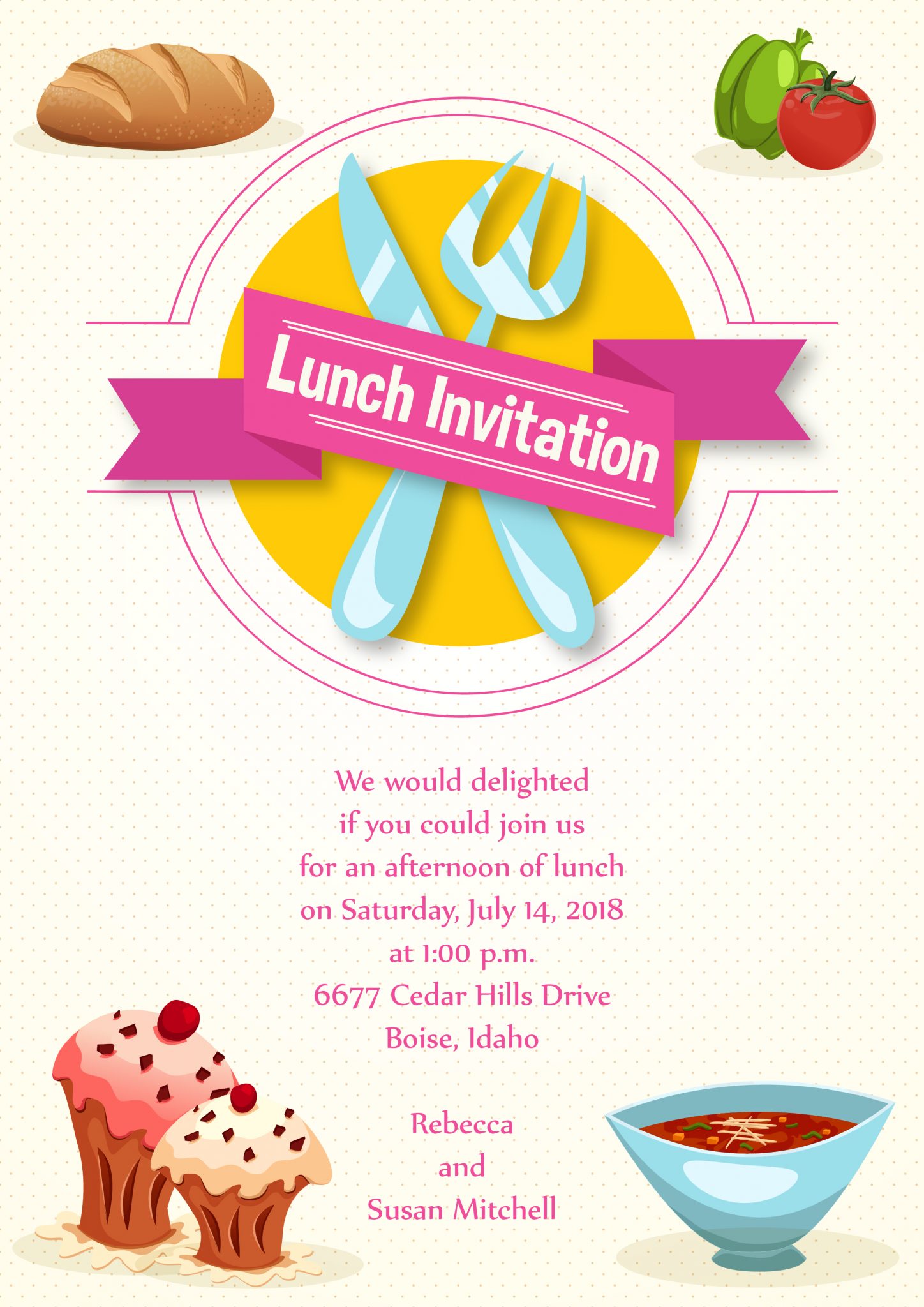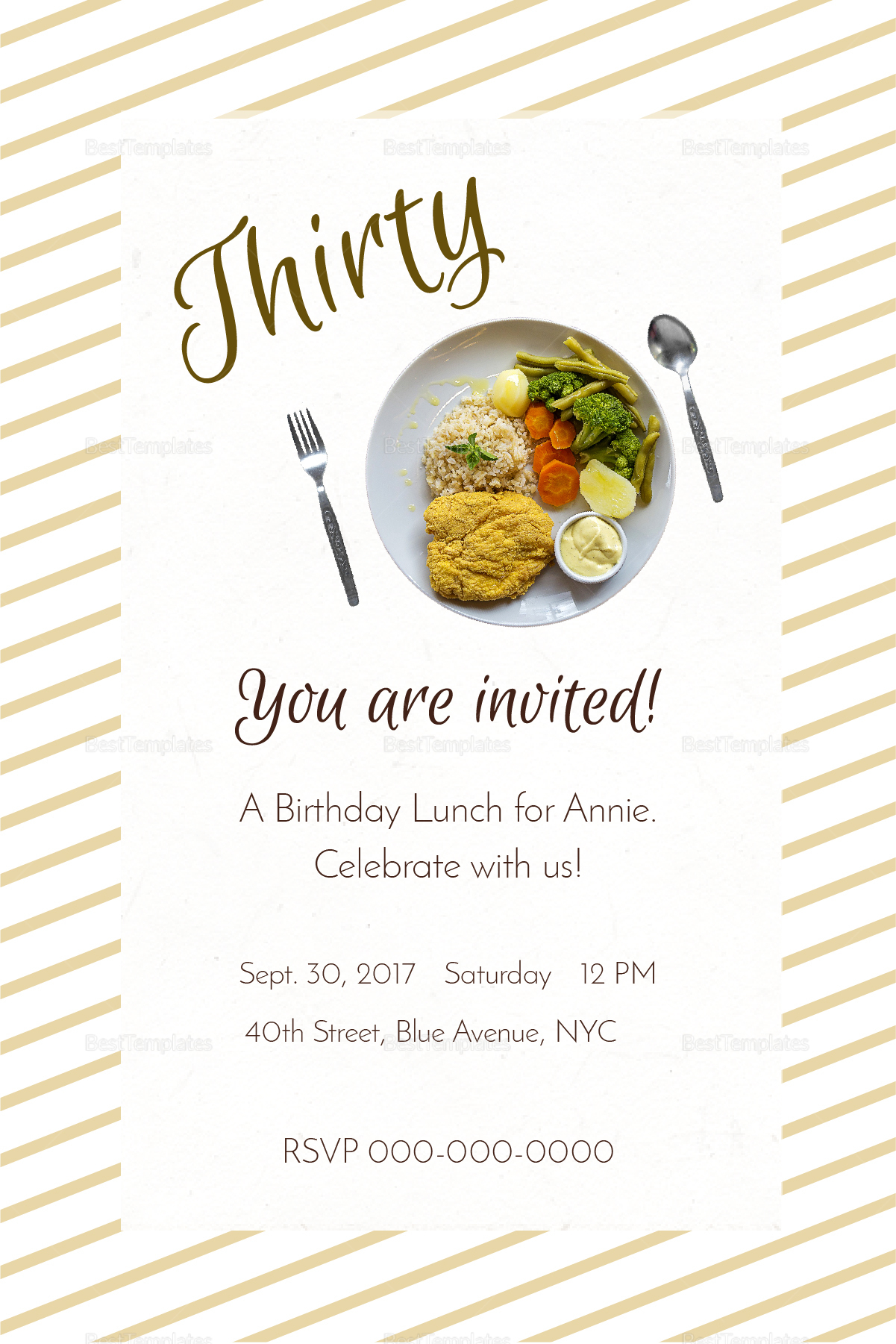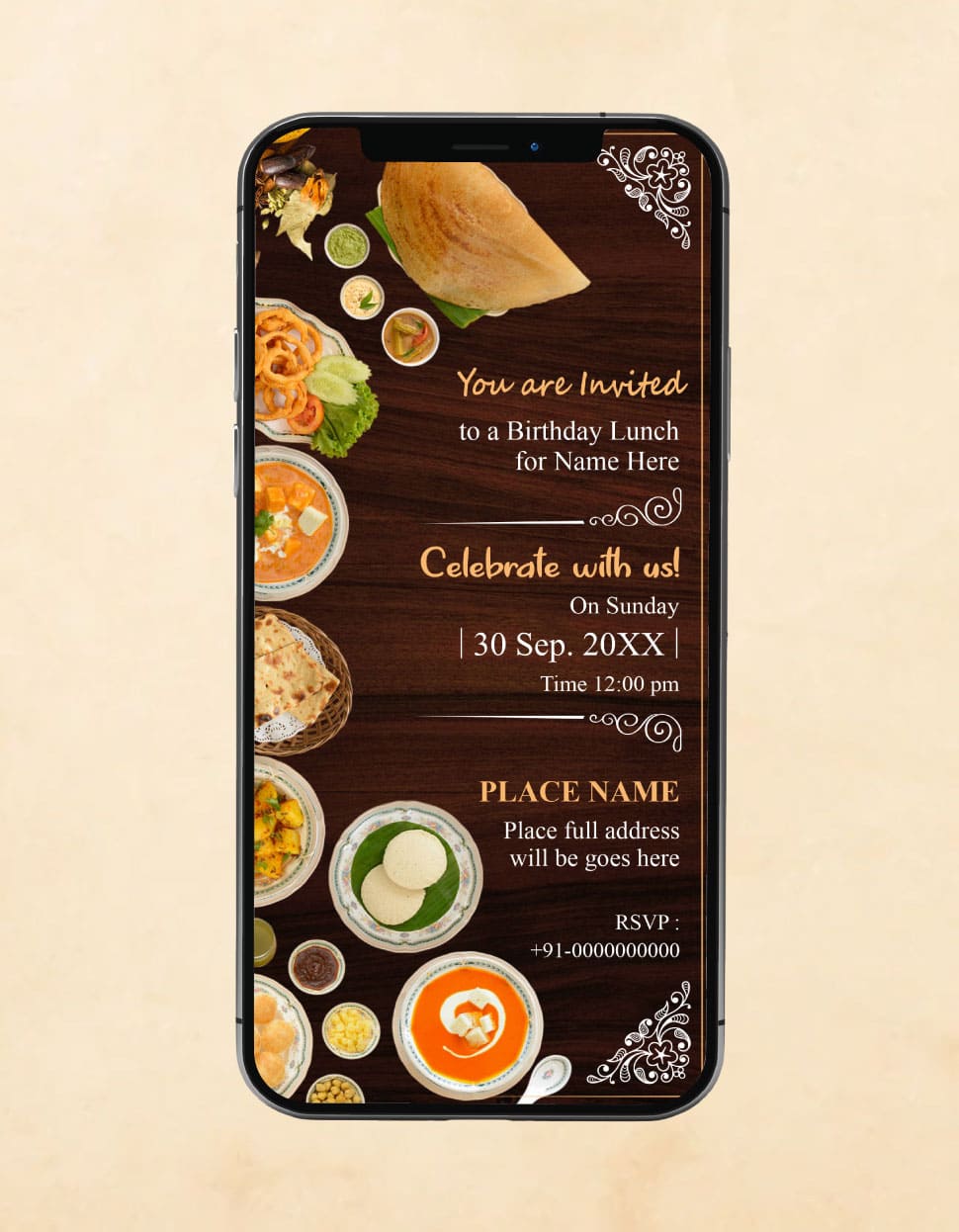Craft A Compelling Lunch Invitation Message | Ultimate Guide
What is a Lunch Invitation Message?
A lunch invitation message is a form of communication requesting someone to join you for lunch. It can be formal or informal. It should include the date, time, and location of the lunch. You may also include a brief note about what you would like to discuss during lunch.
Here are some examples of lunch invitation messages:
- Dear [Name], I would like to invite you to lunch on [Date] at [Time] at [Location]. I would like to discuss [Topic]. Please let me know if you are able to attend.
- Hi [Name], Are you free for lunch on [Date]? I was thinking of [Location]. Looking forward to hearing from you.
Lunch invitation messages are a great way to connect with colleagues, friends, or family members. They can be used to discuss business, catch up on personal news, or simply enjoy a meal together.
Here are some tips for writing a lunch invitation message:
- Be clear and concise.
- State the date, time, and location of the lunch.
- Mention what you would like to discuss (optional).
- Be polite and respectful.
- Send your invitation in advance.
By following these tips, you can write a lunch invitation message that is sure to get a positive response.
Lunch Invitation Message
A lunch invitation message is a form of communication requesting someone to join you for lunch. It is typically concise and includes key details such as the date, time, and location of the lunch. Additionally, it may include a brief note about the purpose of the lunch or any dietary restrictions that need to be considered.
- Date: The date of the lunch should be clearly stated.
- Time: The time of the lunch should be clearly stated.
- Location: The location of the lunch should be clearly stated.
- Purpose: The purpose of the lunch can be briefly stated, such as "to discuss a business proposal" or "to catch up."
- Dietary restrictions: Any dietary restrictions that need to be considered should be briefly stated.
- RSVP: It is often helpful to include an RSVP request, such as "Please RSVP by [date]."
By following these key aspects, you can write a lunch invitation message that is clear, concise, and informative. This will help ensure that your invitation is well-received and that your guest has all the information they need to attend your lunch.
1. Date
The date of the lunch is an essential component of a lunch invitation message. It allows the recipient to determine if they are available to attend the lunch and make any necessary arrangements. Without a clear date, the invitation is incomplete and may not be taken seriously.
There are a few things to keep in mind when stating the date of the lunch:
- Be specific. Don't just say "lunch next week." Instead, specify the exact date, such as "lunch on Tuesday, March 14th."
- Use a format that is easy to understand. The most common way to write a date is to use the month, day, and year, such as "March 14th, 2023." You can also use the day, month, and year, such as "Tuesday, March 14th, 2023."
- Make sure the date is correct. Double-check the date before sending the invitation to avoid any confusion.
By following these tips, you can ensure that the date of your lunch is clearly stated and that your guests have all the information they need to attend.
2. Time
The time of the lunch is an essential component of a lunch invitation message, as it allows the recipient to determine if they are available to attend and make any necessary arrangements. Without a clear time, the invitation is incomplete and may not be taken seriously.
- Facet 1: Punctuality
Punctuality is important in any social or business setting, and this includes lunch invitations. When you state the time of the lunch, be sure to be specific and allow ample time for your guest to travel to the location. For example, if you are inviting someone to lunch at a restaurant that is a 15-minute drive away, you should state the time of the lunch as 15 minutes before the time you actually want to meet. This will give your guest enough time to get to the restaurant without feeling rushed.
- Facet 2: Flexibility
While it is important to be punctual, it is also important to be flexible when it comes to the time of the lunch. Things happen, and sometimes people are running late. If your guest is running late, be understanding and reschedule the lunch for a time that works for both of you.
- Facet 3: Cultural Considerations
The time of the lunch may vary depending on the culture. In some cultures, it is customary to have lunch early, while in other cultures, it is customary to have lunch later. When inviting someone to lunch, be sure to take into account their cultural background and preferences.
By considering these facets, you can ensure that the time of your lunch is clearly stated and that your guests have all the information they need to attend.
3. Location
In a lunch invitation message, the location of the lunch is a vital piece of information that allows the recipient to plan accordingly. Without a clear location, the invitation is incomplete and may not be taken seriously.
- Facet 1: Specificity
When stating the location of the lunch, it is important to be as specific as possible. This means including the name of the restaurant, cafe, or other venue, as well as the address. If the venue is in a large complex, such as a shopping mall or office building, be sure to include directions on how to find it.
- Facet 2: Clarity
The location of the lunch should be stated in a clear and concise manner. Avoid using vague or ambiguous language. For example, instead of saying "Let's meet for lunch at that new place downtown," say "Let's meet for lunch at The New Spot, which is located at 123 Main Street."
- Facet 3: Accessibility
When choosing a location for lunch, it is important to consider the accessibility of the venue for all guests. This includes factors such as the availability of parking, public transportation, and wheelchair accessibility. If the venue is not easily accessible for all guests, be sure to provide alternative arrangements or suggest a different location.
- Facet 4: Ambiance
The location of the lunch can also impact the ambiance of the event. If you are looking for a casual and relaxed atmosphere, choose a venue that is known for its laid-back vibe. If you are looking for a more formal and sophisticated atmosphere, choose a venue that is known for its upscale ambiance.
By considering these facets, you can ensure that the location of your lunch is clearly stated and that your guests have all the information they need to attend. This will help ensure that your lunch invitation is well-received and that your guests have a positive experience.
4. Purpose
In the context of a lunch invitation message, the purpose of the lunch plays a significant role in shaping the tone and content of the message. By stating the purpose of the lunch, the sender provides the recipient with valuable information that helps them decide whether to accept the invitation and how to prepare for the meeting.
- Facet 1: Clarity and Conciseness
When stating the purpose of the lunch, it is important to be clear and concise. Avoid using vague or ambiguous language. For example, instead of saying "Let's meet for lunch to talk about work," say "Let's meet for lunch to discuss the marketing campaign for the new product launch."
- Facet 2: Relevance to Recipient
The purpose of the lunch should be relevant to the recipient. If the recipient is not interested in the topic of the lunch, they are less likely to accept the invitation. When choosing a topic for the lunch, consider the recipient's interests and professional goals.
- Facet 3: Setting Expectations
The purpose of the lunch can help set expectations for the meeting. For example, if the purpose of the lunch is to discuss a business proposal, the recipient will know that the meeting will be focused on business and should come prepared to discuss the proposal in detail.
- Facet 4: Building Relationships
Lunch invitations can be a great way to build relationships. By inviting someone to lunch, you are showing them that you value their company and want to get to know them better. Even if the purpose of the lunch is to discuss business, you can still take some time to chat and get to know each other on a personal level.
By considering these facets, you can ensure that the purpose of your lunch invitation is clearly stated and that your guests have all the information they need to decide whether to accept the invitation and how to prepare for the meeting. This will help ensure that your lunch invitation is well-received and that your guests have a positive experience.
5. Dietary restrictions
In the context of a lunch invitation message, dietary restrictions play a crucial role in ensuring that the event is inclusive and enjoyable for all guests. By briefly stating any dietary restrictions that need to be considered, the sender demonstrates respect for the recipient's dietary choices and preferences.
There are several reasons why it is important to include dietary restrictions in a lunch invitation message:
- Ensuring the guest's safety and well-being: Some dietary restrictions are related to allergies or medical conditions, and it is essential to be aware of these to avoid any potential health risks.
- Showing respect for the guest's choices: Dietary restrictions can be based on personal preferences, religious beliefs, or ethical considerations. By accommodating these restrictions, the sender demonstrates respect for the guest's values and lifestyle.
- Facilitating a positive dining experience: When dietary restrictions are not considered, guests may feel uncomfortable or excluded during the lunch. By taking these restrictions into account, the sender can ensure that all guests can enjoy the meal and have a positive dining experience.
To effectively communicate dietary restrictions in a lunch invitation message, it is important to be clear and specific. Avoid using vague or general terms like "allergies" or "special diets." Instead, provide specific details about the types of foods that the guest cannot or should not consume. For example, you could say "Please note that I have a severe peanut allergy" or "I am following a gluten-free diet." It is also helpful to provide alternative options that meet the guest's dietary needs. For example, you could say "I would be happy to order a gluten-free pizza if that works for you." By providing clear and specific information about dietary restrictions, the sender can ensure that the guest feels comfortable and confident about attending the lunch.
In conclusion, including dietary restrictions in a lunch invitation message is an essential aspect of ensuring inclusivity, respect, and a positive dining experience for all guests. By briefly stating any dietary restrictions that need to be considered, the sender demonstrates thoughtfulness, consideration, and a commitment to creating a welcoming and enjoyable atmosphere for all.
6. RSVP
In the context of a lunch invitation message, including an RSVP request is a common and considerate practice that facilitates effective planning and ensures the smooth running of the event. An RSVP, short for "Rpondez s'il vous plat," is a French phrase that translates to "Please respond." By including an RSVP request in the invitation, the sender politely asks the recipient to indicate whether they will be able to attend the lunch, and by what date they should provide their response.
- Facet 1: Communication and Coordination
An RSVP request establishes a clear line of communication between the sender and the recipient, allowing them to coordinate their schedules and make necessary arrangements. It gives the sender an accurate estimate of the number of guests to expect, enabling them to plan accordingly for seating, food, and other logistical details.
- Facet 2: Respect for Guests' Time and Preferences
Including an RSVP request demonstrates respect for the guests' time and preferences. It allows them to consider their schedules and make an informed decision about whether they can attend the lunch. By providing a specific date for RSVP, the sender gives the guests ample time to respond and avoid any last-minute conflicts or misunderstandings.
- Facet 3: Planning and Preparation
RSVP requests facilitate efficient planning and preparation for the host. Based on the responses received, the host can make informed decisions about the menu, seating arrangements, and any other necessary arrangements. This level of organization ensures that the lunch runs smoothly and that all guests have a positive experience.
- Facet 4: Dietary Accommodations and Special Requests
In some cases, guests may have dietary restrictions or special requests that need to be accommodated. By including an RSVP request, the host can gather this information in advance and make the necessary arrangements to ensure that all guests can enjoy the lunch without any inconvenience.
In conclusion, including an RSVP request in a lunch invitation message serves several important functions. It facilitates communication and coordination, demonstrates respect for the guests' time and preferences, aids in planning and preparation, and allows for accommodating dietary restrictions or special requests. By incorporating an RSVP request, hosts can ensure that their lunch invitation is well-received, and that the event runs smoothly and enjoyably for all attendees.
FAQs on Lunch Invitation Messages
Lunch invitation messages are a common and important aspect of social and business communication. They serve to request someone's presence at a lunch meeting or gathering, and should be crafted with care and consideration. Here are answers to some frequently asked questions about lunch invitation messages:
Question 1: What are the essential elements of a lunch invitation message?A well-crafted lunch invitation message should include the following elements:
- Date and time: The specific date and time of the lunch should be clearly stated.
- Location: The name and address of the restaurant or venue should be included.
- Purpose: A brief description of the purpose of the lunch, such as "to discuss a business proposal" or "to catch up," can be helpful.
- RSVP information: A request for the recipient to RSVP by a certain date is essential for planning purposes.
To make your lunch invitation message more effective, consider the following tips:
- Be clear and concise: Use precise language and avoid unnecessary details.
- Be specific: Provide all the necessary information, including the date, time, location, and purpose of the lunch.
- Be polite and respectful: Use courteous language and avoid making assumptions about the recipient's availability.
- Be timely: Send your invitation with enough advance notice to allow the recipient to make arrangements.
If you need to cancel or reschedule a lunch invitation, it is important to do so promptly and politely. Contact the recipient as soon as possible and apologize for any inconvenience. If possible, offer an alternative date and time for the lunch.
Question 4: Can I use email to send a lunch invitation?Yes, email is an acceptable method for sending a lunch invitation. However, it is important to follow the same principles of clarity, conciseness, and politeness as you would with a written invitation.
Question 5: What is the best way to follow up on a lunch invitation?If you have not received a response to your lunch invitation within a reasonable amount of time, it is acceptable to follow up with the recipient. You can send a brief email or make a phone call to confirm their attendance.
By following these guidelines, you can create effective and appropriate lunch invitation messages that will be well-received by your recipients.
Additionally, here are some general tips to keep in mind when crafting lunch invitation messages:
- Be genuine: Your invitation should reflect your sincere desire to meet with the recipient.
- Be personal: If appropriate, include a personal touch in your invitation, such as a reference to a shared interest or experience.
- Be professional: Even for informal lunches, it is important to maintain a professional tone in your invitation.
- Be thoughtful: Consider the recipient's dietary restrictions or preferences when choosing a restaurant or menu.
Transition to the next article section:
Lunch Invitation Message
In conclusion, a lunch invitation message serves as a formal or informal request to invite someone to join for lunch. It typically includes essential elements such as the date, time, location, and purpose of the meeting. Effective lunch invitation messages are clear, specific, polite, and timely, considering the recipient's preferences and dietary restrictions. By following the guidelines and tips outlined in this article, you can craft well-written and appropriate lunch invitation messages that will be well-received and contribute to successful gatherings.
Lunch invitation messages play a vital role in facilitating social and business interactions. They allow individuals to connect, build relationships, and discuss matters in a relaxed and informal setting. By understanding the importance and nuances of lunch invitation messages, you can effectively communicate your request and ensure a positive response from the recipient.
- Jung Hae In Kim Soo Hyun
- Tony Hawk Net Worth
- Chicago Bears Qb
- Jake Gyllenhaal Height In Feet
- Wedding Jesse Metcalfe Wife

Amazing Invitation Vector Lunch Invitation Vector Invitation Template

Birthday Lunch Invitation Design Template in PSD, Word, Publisher

Lunch Invitation Card